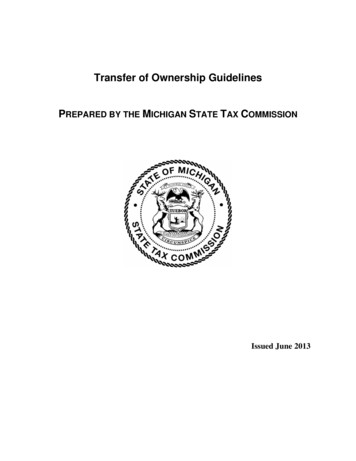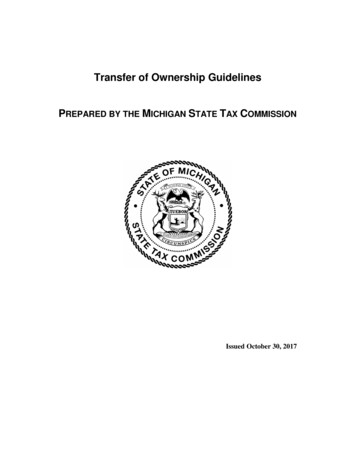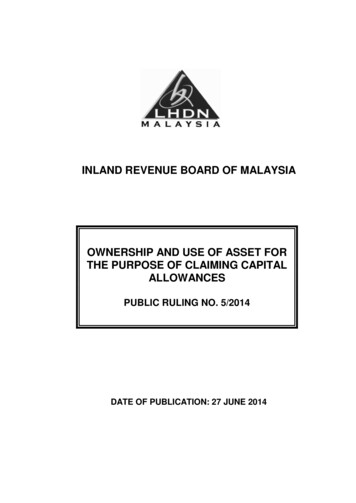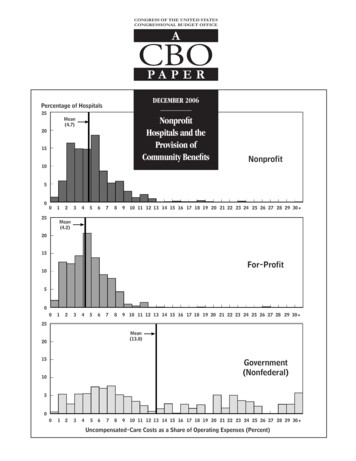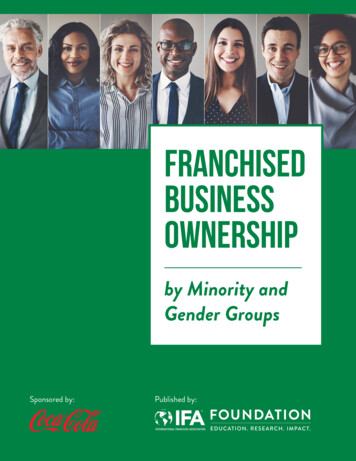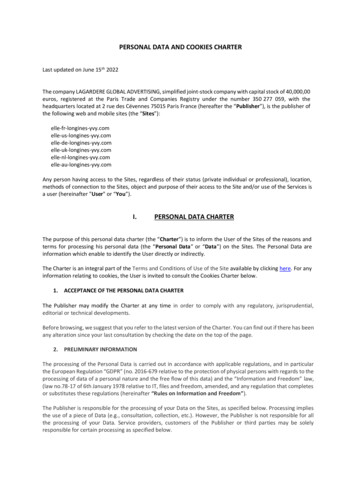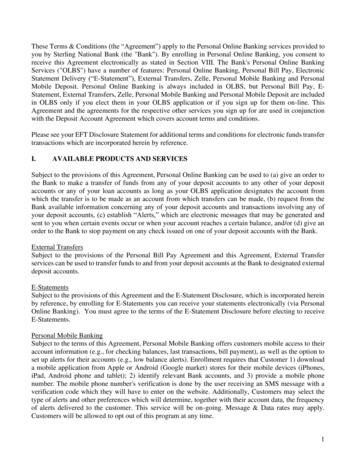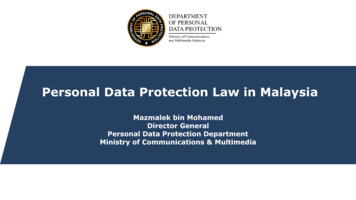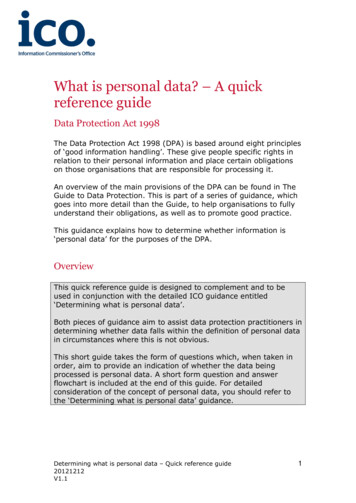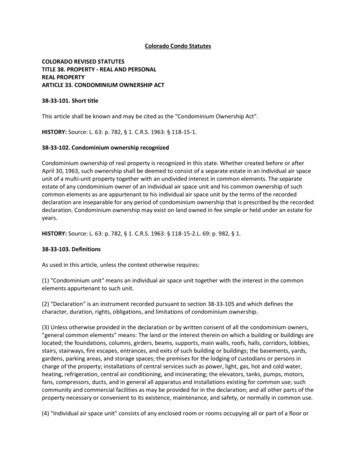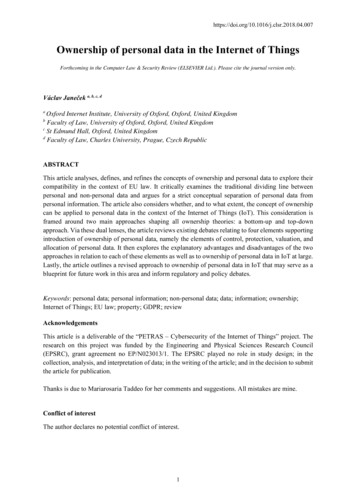
Transcription
p of personal data in the Internet of ThingsForthcoming in the Computer Law & Security Review (ELSEVIER Ltd.). Please cite the journal version only.Václav Janeček a, b, c, daOxford Internet Institute, University of Oxford, Oxford, United KingdomFaculty of Law, University of Oxford, Oxford, United KingdomcSt Edmund Hall, Oxford, United KingdomdFaculty of Law, Charles University, Prague, Czech RepublicbABSTRACTThis article analyses, defines, and refines the concepts of ownership and personal data to explore theircompatibility in the context of EU law. It critically examines the traditional dividing line betweenpersonal and non-personal data and argues for a strict conceptual separation of personal data frompersonal information. The article also considers whether, and to what extent, the concept of ownershipcan be applied to personal data in the context of the Internet of Things (IoT). This consideration isframed around two main approaches shaping all ownership theories: a bottom-up and top-downapproach. Via these dual lenses, the article reviews existing debates relating to four elements supportingintroduction of ownership of personal data, namely the elements of control, protection, valuation, andallocation of personal data. It then explores the explanatory advantages and disadvantages of the twoapproaches in relation to each of these elements as well as to ownership of personal data in IoT at large.Lastly, the article outlines a revised approach to ownership of personal data in IoT that may serve as ablueprint for future work in this area and inform regulatory and policy debates.Keywords: personal data; personal information; non-personal data; data; information; ownership;Internet of Things; EU law; property; GDPR; reviewAcknowledgementsThis article is a deliverable of the “PETRAS – Cybersecurity of the Internet of Things” project. Theresearch on this project was funded by the Engineering and Physical Sciences Research Council(EPSRC), grant agreement no EP/N023013/1. The EPSRC played no role in study design; in thecollection, analysis, and interpretation of data; in the writing of the article; and in the decision to submitthe article for publication.Thanks is due to Mariarosaria Taddeo for her comments and suggestions. All mistakes are mine.Conflict of interestThe author declares no potential conflict of interest.1
https://doi.org/10.1016/j.clsr.2018.04.0071 IntroductionInternet of Things (IoT) technologies are becoming increasingly more pervasive. Within the EU28alone, the estimated number of connected ‘things’ was 1.8 billion in 2013 and is expected to reach 6billion by 2020.1 These so-called ‘smart’ devices will foster our interactions with the environment byfacilitating transport and logistics, for example, as well as delivery of services like healthcare andsecurity. At the same time, IoT devices generate and collect a wealth of personal data, whosemanagement poses serious ethical2 and legal3 questions. Ownership of personal data underpins theissues revolving around data management and control, such as privacy, trust,4 and security, and it hasalso important implications for the future of the ‘digital’ economy and trade in data.5 This is why debateson introducing the concept of data ownership as a legal right have recently emerged at the EU level6and beyond,7 and why they are still thriving, although the majority of the legal doctrine and now alsothe European Commission have reservations about the data ownership concept.1234567S Aguzzi and others, Definition of a Research and Innovation Policy Leveraging Cloud Computing and IoTCombination (European Commission 2014) 10, 26, 61.Globally, the number of connected devices is expected to grow from 9 billion in 2013 up to 50 billion by2020: OECD, OECD Digital Economy Outlook 2017 (OECD Publishing 2017) 247; GAO, Technologyassessment: Internet of Things: Status and implication of an increasingly connected world (GAO-17-75,May 2017) 1; McKinsey Global Institute, The Internet of Things: Mapping the Value Beyond the Hype(McKinsey 2015) 17.J Van den Hoven, Internet of Things Factsheet Ethics (European Commission 2013).See J Drexl and others, ‘Data Ownership and Access to Data – Position Statement of the Max Planck Institutefor Innovation and Competition of 16 August 2016 on the Current European Debate’ (2016) Max PlanckInstitute for Innovation & Competition Research Paper No 16-10 https://ssrn.com/abstract 2833165 accessed 16 November 2017.M Taddeo, ‘Trusting Digital Technologies Correctly’ (2017) 27 Minds & Machines 565; M Taddeo, ‘Trustin Technology: A Distinctive and a Problematic Relation’ (2010) 23 Know Tech Pol 283.See, eg, TJ Farkas, ‘Data Created by the Internet of Things: The New Gold without Ownership’ (2017) 23Rev Prop Inmaterial 5, 14; C Bartolini, C Santos and C Ullrich, ‘Property and the cloud’ (2018) 34 CLSRev358; V Gazis and others, ‘Short Paper: IoT: Challenges, projects, architectures’ (2015) 18 InternationalConference on Intelligence in Next Generation Networks 145; A Whitmore, A Agarwal and L Da Xu, ‘TheInternet of Things—A survey of topics and trends’ (2015) 17 Inf Syst Front 261, 266; IERC – EuropeanResearch Cluster on the Internet of Things, Internet of Things: IoT governance, privacy and security issues(European Commission 2015) 10, 78–79.See, eg, Commission, ‘Building a European Data Economy’ (Communication) COM (2017) 9 final, 9–10,13; Commission, ‘On the free flow of data and emerging issues of the European data economy,accompanying COM (2017) 9 final’ (Commission Staff Working Document) SWD (2017) 2 final, esp. 23,33–38; Osborne Clarke LLP, Legal study on ownership and access to data (European Commission 2016) ship-and-access-to-data-pbKK0416811/ [https://perma.cc/82D8-9787]; N Duch-Brown, B Martens and F Mueller-Langer, ‘The Economics ofOwnership, Access and Trade in Digital Data’ (JRC Digital Economy Working Paper 2017-01, EuropeanCommission 2017) 12ff 56.pdf [https://perma.cc/NUM8HVWB]; A Gärtner and K Brimsted, ‘Let's talk about data ownership’ (2017) 39 EIPR 461; S van Erp,‘Ownership of Data: The Numerus Clausus of Legal Objects’ (2017) 6 Brigham-Kanner Property RightsConference Journal 235; S Lohsse, R Schulze and D Staudenmayer (eds), Trading Data in the DigitalEconomy: Legal Concepts and Tools (Nomos/Hart Publishing 2017); F Thouvenin, RH Weber and A Früh,‘Data ownership: Taking stock and mapping the issues’ in M Dehmer and F Emmert-Streib (eds), Frontiersin Data Science (CRC Press 2018). Thanks is due to Stephen Saxby for bringing my attention to the 2018publication.Globally, see, eg, IEEE Global Initiative on Ethics of Autonomous and Intelligent Systems, Ethically AlignedDesign: A Vision for Prioritizing Human Well-being with Autonomous and Intelligent Systems (version 2)(IEEE 2017) 141–42, 237–38, 247 [https://perma.cc/W5MT-VK9K]; McKinsey Global Institute (n 1) 11,26, 104, 106, 107 and 113. For India, see Telecom Regulatory Authority of India, Consultation Paper onPrivacy, Security and Ownership of the Data in the Telecom Sector (TRAI Consultation No 09/2017) 2 and2
https://doi.org/10.1016/j.clsr.2018.04.007Due to legal developments in personal data protection, starting with the fundamental right to respect forprivate life,8 over the fundamental right to protection of personal data,9 and recently culminating by thedata subject’s rights granted by the General Data Protection Regulation (GDPR),10 it became impossibleto think of any data ownership without also thinking about ownership of personal data. The problem is,however, that the line between personal and non-personal data is a moving target and data that are nowseen as non-personal data may become (thanks to analytical and technological advancements) personaldata in the future.11 Thus, exploring the conceptual limits of ownership of personal data must precededebates on ownership of purely non-personal data (eg data employed in smart farming).12 In fact,personal data have already been recognized as one of the key economic assets,13 and avoiding questionsregarding their ownership is thus problematic even in the light of these economic trends. Moreover, theneed for the analysis stems from the nature of the IoT world in which many of us already live. Take,for instance, ‘smart cities’ where big data companies may soon be able to privatize data (includingpersonal data), despite them being largely collected without prior consent of data subjects.14 In responseto these challenges, a number of ownership-like types of technological solution are also emerging. Onesuch example is the AURA platform—a Personal Information Management system (PIM)15—whichwas recently introduced by Telefónica in Spain and which, in contrast with trends in the smart cities,allows end-users to control relevant data that their mobile operator holds about them (eg the user’sgeolocation) and to decide with whom these data will be shared.1689101112131415166 [https://perma.cc/ES29-ZVA4]. Thanks is due to Ashok Rajagopalan for bringing my attention to thisIndian document. For Australia, see Productivity Commission, Data Availability and Use (Report No 82,2017) 53, 65, 66, 177, 191, 196, 241 and 584 [https://perma.cc/6RKE-PCGL]. For China, see Arts 45 and48 of the First Draft E-Commerce Law of the People’s Republic of China (published 27 December 2016).Thanks is due to Vicky Cheng for bringing my attention to this Chinese document. For the USA, see OsborneClarke LLP (n 6) 78–81. For the United Kingdom (if seen as a potential non-EU member), see ta/ [https://perma.cc/73JB-8QJU].Art 8 of the Convention for the Protection of Human Rights and Fundamental Freedoms 1950.Art 8 of the Charter of Fundamental Rights of the European Union [2012] OJ C326/391.Regulation (EU) 2016/679 of the European Parliament and of the Council of 27 April 2016 on the protectionof natural persons with regard to the processing of personal data and on the free movement of such data, andrepealing Directive 95/46/EC (General Data Protection Regulation) (OJ L 119/2016).C Wendehorst, ‘Of Elephants in the Room and Paper Tigers: How to Reconcile Data Protection and the DataEconomy’ in Lohsse, Schulze and Staudenmayer (eds) (n 6) 332.See S Wolfert and others, ‘Big Data in Smart Farming – A review’ (2017) 153 Agricultural Systems 69; JDrexl, ‘Designing Competitive Markets for Industrial Data – Between Propertisation and Access’ (2017) 8JIPITEC 257. cf also Commission, ‘Proposal for a Regulation of the European Parliament and of the Councilon a framework for the free flow of non-personal data in the European Union’ COM (2017) 495 final;Commission, ‘Proposal for a Regulation of the European Parliament and of the Council concerning therespect for private life and the protection of personal data in electronic communications and repealingDirective 2002/58/EC (Regulation on Privacy and Electronic Communications)’ COM (2017) 10 final.World Economic Forum, Personal Data: The Emergence of a New Asset Class (Geneva 2011) http://www3.weforum.org/docs/WEF ITTC PersonalDataNewAsset Report 2011.pdf [https://perma.cc/T7JL-BZXK].See L Edwards, ‘Privacy, Security and Data Protection in Smart Cities: A Critical EU Law Perspective’(2016) 2 EDPLR 28, 29, 33–34.European Data Protection Supervisor, ‘EDPS Opinion on Personal Information Management Systems’(Opinion No 9/2016) /16-10-20 pims opinion en.pdf [https://perma.cc/X236-GR48].Telefónica, ‘Telefónica presents AURA, a pioneering way in the industry to interact with customers basedon cognitive intelligence’ (press release, 26 February 2017) -intelligence [https://perma.cc/F59Q-LV74]. In 2018, the platform will be launched also in3
https://doi.org/10.1016/j.clsr.2018.04.007In this article, I analyse, define, and refine the concepts of ownership and personal data to bring existingdebates about ownership of personal data to common ground (Section 2). Then I review theories ofownership and reasons supporting ownership of personal data to consider whether, and to what extent,the concept of ownership can be applied to personal data in IoT. My analysis is framed around two mainapproaches shaping all ownership theories: a bottom-up and top-down approach. I contrast these twoapproaches by looking at whether stabile ownership is yet to be created by positive law (the top-downapproach) or whether positive law is meant to stabilize already existing, though instable, de factoownership (the bottom-up approach). Via these dual lenses, I review reasons explaining and justifyingpropertisation of personal data in IoT as well as reasons supporting to whom these data should belong.My aim is to unveil the advantages and disadvantages of the two approaches and to frame the existingdebates (Section 3). To show potential directions for consistent and sustainable policies and law-makingin this regard, I outline a revised approach to ownership of personal data that may serve as a blueprintfor developing this intellectual structure, should it be introduced in the first place (Section 4). Finally,I conclude that—in the context of the EU law—either a revised bottom-up approached ownership theoryis needed or data ownership initiatives are to be, at least partially, repealed (Section 5).Lastly, a terminological point needs to be made. In this article, I use the phrase ‘ownership of personaldata’, because the expression ‘personal data ownership’, albeit stylistically more elegant, invites unclearand biased thinking by signalling that the personal data should be owned personally by the data subject.The desired allocation of ownership, however, is yet to be explored in this paper.2 The concepts of ownership and personal data in the context of European law2.1 OwnershipSince the concept of ownership is not defined at the EU-law level,17 and since national legal systemsdefine ownership differently, I first conceptually canvass a minimal definition of ownership. From acomparative viewpoint, a main distinction can be drawn between the civil law and common lawunderstanding of ownership.18 The civil law recognizes a limited number of property rights and a limitednumber of legal objects that can be subjected to these property rights (the so-called numerus clausus).19In contrast, the common law is more flexible and allows private parties more freedom in the types ofownership interests which they can create.20 Therefore, the civilian idea of ownership is an absolutedominion encompassing all the listed rights (numerus clausus) over the relevant object; whereas in thecommon law tradition, ownership includes a variety of different rights over the same property. Incommon law, therefore, ownership can be gradual: you can have more or less ownership depending onhow large the bundle of your property rights in the object is. To overcome this civil law/common law17181920Germany, the UK, Brazil, Argentina and Chile, possibly expanding to 11 markets by 2020 (Telefonica tolaunch Aura AI platform in 6 markets in February (telecomaper news, 30 November 2017) 2638 [https://perma.cc/EES2-YM2M]).See more in S van Erp and B Akkermans, ‘European Union property law’ in C Twigg-Flesner (ed), TheCambridge Companion to European Union Private Law (CUP 2010) 173.See U Mattei, Basic Principles of Property Law: A Comparative Legal and Economic Introduction(Greenwood Press 2000) ch 1; M Graziadei, ‘The structure of property ownership and the common law/civillaw divide’ in G Michele and S Lionel (eds), Comparative Property Law: Global Perspectives (EdwardElgar Publishing 2017).van Erp (n 6) 235; B Akkermans, The Principle of Numerus Clausus in European Property Law (Intersentia2008); J Gordley, Foundations of Private Law: Property, Tort, Contract, Unjust Enrichment (OUP 2006)49.Gordley (n 19) 49; van Erp (n 6) 236.4
https://doi.org/10.1016/j.clsr.2018.04.007divide and to avoid conceptual issues stemming from the debate about the nature of ownership,21 I referto ownership as to a full-ownership, ie a bundle of all property rights. Such working definition can beacceptable in both legal traditions.The second important comparative observation is that the civil law considers ownership an absoluteright erga omnes, ie a right that gives rise to legal protection of property against everyone, whereascommon law recognizes personal property rights (in personam) and real property rights (in rem) ofwhich only the latter are exigible against the entire world.22 This is why common lawyers can conceiveof ownership of personal data as giving the owner a legal protection both relative to a particular person(ownership rights in personam) and absolutely against everyone (ownership rights in rem).23 To clearthe ground for analysing ownership of personal data in IoT in Europe, I proceed with an absoluteconcept of ownership to accent the common erga omnes/in rem feature of ownership in both mainEuropean legal traditions. Besides, the European Commission used the same understanding ofownership with regard to data in its communication from 2017,24 which further justifies my restrictiveinterpretation of the term.Conceptually, then, ownership entails four elements that jointly answer the ‘Who owns what?’question—an element of control, protection, valuation, and allocation of a resource. Let me explain thisidea. Ownership rights have an active and passive aspect, giving the owner full-blown active control orfull-blown passive protection of the resource. These active and passive rights relate to a valuable object,ie an object that is worth controlling and protecting. Thus, when the law guarantees a full-blown ergaomnes/in rem control and protection over a valuable resource, we can speak of propertisation of theresource—the resource turns into property. Subsequently, it becomes necessary to allocate suchproperty to someone. In Section 3, I analyse all four elements to explore why the law should allowsomeone to control and protect personal data, and to whom these valuable data should be allocated.2.2 Personal dataPersonal data are now legally defined in Article 4(1) of the GDPR as follows:‘[P]ersonal data’ means any information relating to an identified or identifiable naturalperson (‘data subject’) [ ].This definition illustrates the slippery language regarding personal data. On one hand, the GDPR,Recital 68 explicitly wants to ‘strengthen the [natural person’s] control over his or her own data’(emphasis added), thereby making a step towards ‘data subjects’ default ownership of their personaldata’.25 On the other hand, personal data are also referred to in the GDPR as ‘personal information’26or simply as ‘information’27 relating to a natural person. This understanding, however, overlooks theconceptual distinction between data and information and has crucial implications when it comes toownership of personal data as opposed to ownership of personal information.21222324252627A Ross, ‘Tû-Tû’ (1957) 70 HarvLRev 812; JR Pennock and JW Chapman, Property (New York UP 1980).More recently, eg, J Waldron, ‘“To Bestow Stability upon Possession” – Hume’s Alternative to Locke’ in JPenner and HE Smith (eds), Philosophical Foundations of Property Law (OUP 2013).Gordley (n 19) 49; Mattei (n 18) 8–9.C Rees, ‘Who owns our data?’ (2014) 30 CLSRev 75, 77–78.Commission, ‘On the free flow of data ’ (n 6) 33.Recital 68 of the GDPR (emphasis added). See also Recital 7 of the GDPR.Recital 6 of the GDPR (emphasis added).Art 4(1) of the GDPR (emphasis added). See also Article 29 Data Protection Working Party, ‘Opinion 4/2007on the Concept of Personal Data’ (WP 136, 20 June 2007).5
https://doi.org/10.1016/j.clsr.2018.04.007Data and information are two distinct concepts. Imagine a stone containing Egyptian hieroglyphs. Untilthe discovery of the Rosetta Stone, the very same piece of writing would represent all the data, butconvey no meaningful information to its reader.28 Data can be defined as ‘putative fact[s] regardingsome difference or lack of uniformity within some context’.29 In the given scenario, data are representedby the hieroglyphs and as such they are the source of information, depending on how we interpret them.There is thus no data-less information. This means that we need not to understand the information thatany data may convey in order to treat the data as an asset from which valuable information may beextracted in the future.In debates on data ownership, however, a clear conceptual distinction between data and information ismissing.30 The legal debates build on a related yet conceptually very distinct differentiation between theform (usually digital form) in which information is embodied and the meaning contained in that form(information itself). This difference has recently been described as a distinction between the syntacticlevel of information (the form) and the semantic level of information (the meaning).31 For the purposesof discussing data ownership, this approach cannot bring the desired level of clarity, though, because itconfuses syntactic information with data.The confusion between the syntactic level of information (as a formal representation of information)and the data (as a source of identical information) originates from an information-centred starting pointof these legal debates. The original question featuring in said debates was ‘When information (not data)can be protected by the law?’ and the answer was that while semantic information (ie information perse) can never be protected by the law because it would violate free access to information,32 syntacticinformation can be given legal protection.33 From the information-centred viewpoint this answer wassatisfactory. Saying that syntactic information or more precisely the formal expression of information,for example in form of a digital sequence of data, can be legally protected addressed the relevantinformation-centred problem. The data-centred discourse, however, cannot make efficient use of thisconceptual scheme, because its original questions are ‘How can we protect data?’ and ‘Whatinformation can be extracted from data?’, not ‘How can we express some information in form of (egdigital) data?’.The fact that the same data can be analysed in indefinite ways also gave rise to the concern that datacollected in IoT environments may eventually reveal sensible personal information. Some argue that282930313233This example is taken from L Floridi, ‘Is Semantic Information Meaningful Data?’ (2005) 70 Philosophyand Phenomenological Research 351, 359.L Floridi, ‘Semantic Conceptions of Information’, The Stanford Encyclopedia of Philosophy (Spring edn,2017) s/information-semantic/ accessed 15 November2017.See, eg, G Malgieri, ‘Property and (Intellectual) Ownership of Consumers’ Information: A New Taxonomyfor Personal Data’ (2016) 4 Privacy in Germany 133; N Purtova, ‘Property in Personal Data: Second Life ofan Old Idea in the Age of Cloud Computing, Chain Informatisation, and Ambient Intelligence’ in S Gutwirthand others (eds), Computers, Privacy and Data Protection: An Element of Choice (Springer Netherlands2011) 39; N Purtova, ‘Property rights in personal data: Learning from the American discourse’ (2009) 25CLSRev 507, 507; N Purtova, Property Rights in Personal Data: A European Perspective (Wolters KluwerLaw & Business 2012) 129; Gärtner and Brimsted (n 6) 464; Rees (n 23); van Erp (n 6) 247, 251; A DeFranceschi and M Lehmann, ‘Data as Tradeable Commodity and New Measures for their Protection’ (2015)1 Italian LJ 51, 51–52.Commission, ‘On the free flow of data ’ (n 6) 34; Lohsse, Schulze and Staudenmayer (eds) (n 6); H Zech,‘Information as Property’ (2015) 6 JIPITEC 192; Thouvenin, Weber and Früh (n 6) 120–21.van Erp (n 7) 244; De Franceschi and Lehmann (n 30) 66.Commission, ‘On the free flow of data ’ (n 6) 34; Zech (n 31).6
https://doi.org/10.1016/j.clsr.2018.04.007the same piece of data can be interpreted as substantiating both personal and non-personal informationdepending on the context and purpose of its use, which leads to erosion of the line between personaland non-personal data.34 Privacy advocates would therefore argue that since control over any dataimplies risk of control over personal information (not vice versa), it would be practically impossible toenforce informational privacy if someone could control any data by owning them exclusively.35 Thisreasoning can quickly lead to quite radical conclusions—no exclusive data control, no data ownership,no trade in data. The property and market advocates, in contrast, would want to utilize the data andtherefore secure stabile control over them. In their perspective, all massively collected data in IoTenvironments (except for the special class of data that are collected and identified as personal data fromthe outset) can be controlled, owned, and traded by anyone in principle.The root of this problem is that EU law defines personal data reversely: data are the source ofinformation which, if personal, reversely implies that the original data are also personal. This definitionleads into a seemingly paradoxical situation in which no data are personal from the outset and all datacan become personal from the outset. The clash between privacy and property advocated then lookslike a chicken/egg problem in which it is unclear which of the two comes first: information-centredprivacy arguments prioritize the personal chicken; data-centred property arguments are on the side ofthe data egg. However, the problem of personal information and data is a different one. The trick is thatan egg made of data does not need to reveal or contain the chicken’s personal information in everysingle case and can still can be considered valuable and worth protecting. We may value the egg atdifferent levels of abstraction than is the level of personal information. For example, the egg containsprecious albumen as well as information about resistant constructions—you may try to crack it in yourfist yourself. Data and information simply cannot be compared with each other at the same level ofanalysis because they are fundamentally different categories. On this account, it is clear that personaland non-personal data are not conceptually incompatible categories.To reconcile both views, ie to allow personal-information-centred privacy as well personal-data-centredcontrol, we need to restrict the scope of the potentially so controlled personal data from an oppositedirection. The key question must be whether some data contain personal information intrinsically andtherefore cannot be defined as non-personal data from the outset. Examples of such data can be seen inthe jurisprudence of the European Court of Human Rights (ECtHR). According to the ECtHR, a humanDNA sequence or human cellular samples36 ‘contain substantial amounts of unique personal data’37 andmerely retaining them invades, without further justification, the fundamental human right to privacyunder Article 8 of the European Convention on Human Rights from 1950. The reason why even theleast form of control over these data (eg their retention) constitutes breach of personality rights is that,given the current state of knowledge, there is no meaningful interpretation of these data, according towhich they do not objectively allow us to identify the individual data subject. These unique personaldata contain ‘intrinsically private information’38 and controlling them is therefore almost like3435363738See Commission, ‘On the free flow of data ’ (n 6) 34; Commission, ‘Proposal for a Regulation of theEuropean Parliament and of the Council on a framework for the free flow of non-personal data in theEuropean Union’ COM (2017) 495 final; Osborne Clarke LLP (n 6) 41; N Purtova, ‘Do property rights inpersonal data make sense after the Big Data turn? Individual control and transparency’ (2017) Tilburg LawSchool Research Paper No 2017/21, 13–17 https://ssrn.com/abstract 3070228 accessed 11 December2017.Purtova (n 34) 13–17.Aycaguer v France App no 8806/12 (ECtHR, 22 June 2017), (2017) EHRLR 519; S v United Kingdom(2009) 48 EHRR 50 (ECtHR).S v United Kingdom (n 36) [75].ibid [104].7
ing one’s individual identity. To use the chicken/egg analogy, these data reveal the chicken’spersonal information in every case. Thus, such intrinsically personal data must be excluded from mydefinition of personal data for the purposes of ownership issues, albeit they represent the core type ofpersonal data as defined by the GDPR (note that the GDPR defines ‘personal data’ in Article 4exclusively for the purposes of that regulation).The main argument for excluding the intrinsically personal data from the scope of debates about dataownership combines conceptual, ethical, as well as legal aspects. One may argue that, from anontological point of view, such data are constitutive of one’s own identity, because ‘there is nodifference between one’s informational sphere [construed by these intrinsically personal data] and one’spersonal identity’.39 Ownership of such data would thus conceptually imply ownership of people’sidentities and the owner of the intrinsically personal data cannot exclude the individual’s demands onthese data unless he/she neglects the individual’s identity in the first place. Consequently, exclusivecontrol of such data would be analogical to slave-holding or human trafficking, which is ethicallypr
assessment: Internet of Things: Status and implication of an increasingly connected world (GAO-17-75, May 2017) 1; McKinsey Global Institute, The Internet of Things: Mapping the Value Beyond the Hype (McKinsey 2015) 17. 2 J Van den Hoven, Internet of Things Factsheet Ethics (European Commission 2013).
